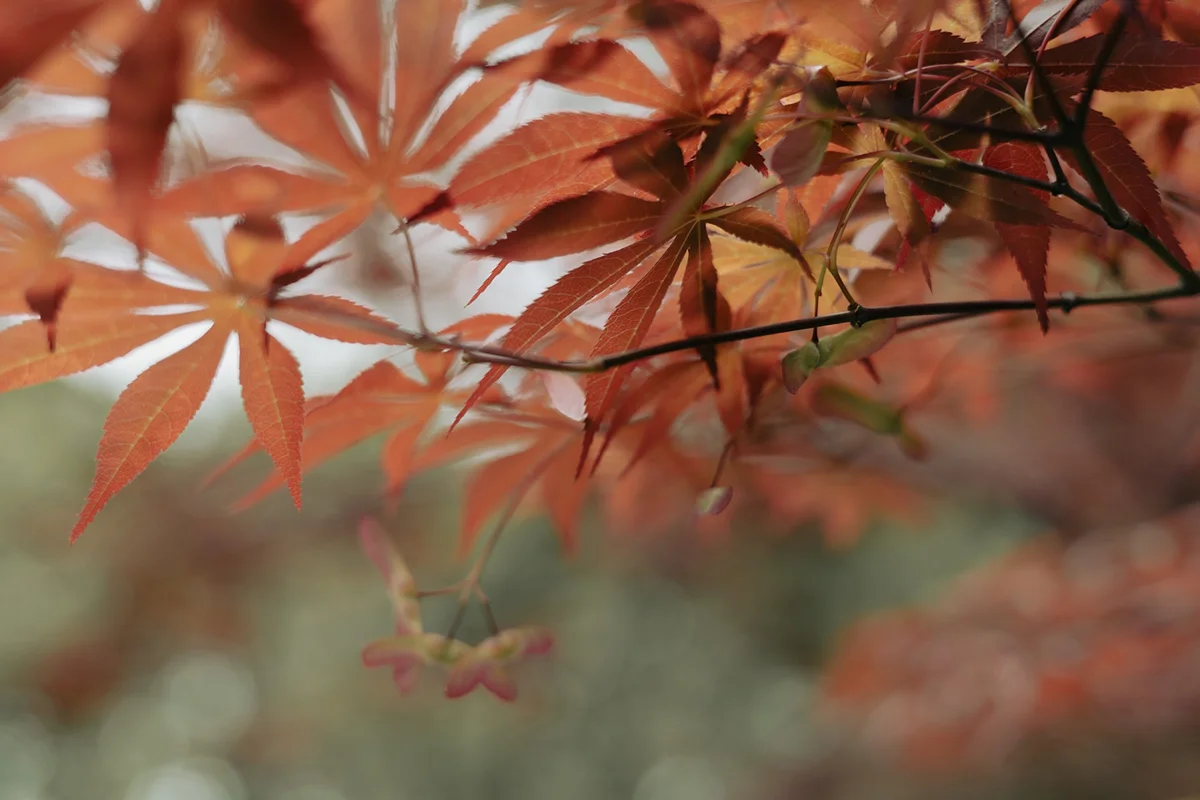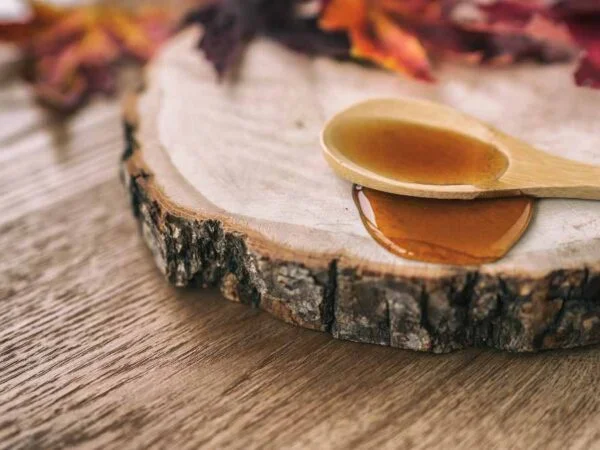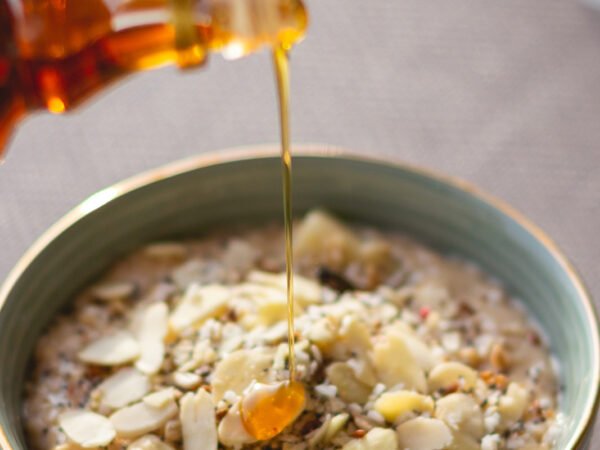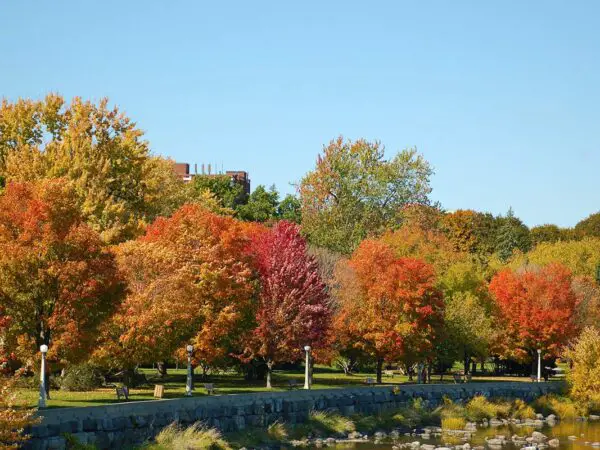
Have you ever wondered how fast sugar maple trees actually grow? Well, let me tell you, these majestic trees may not be sprinters, but they certainly know how to keep a steady pace. The growth rate of sugar maple trees can vary depending on a multitude of factors, making it an intriguing subject for tree enthusiasts and arborists alike. Managing these trees effectively requires a deep understanding of their growth rate and the factors that influence it. So, if you're ready to delve into the fascinating world of sugar maple tree growth rates, buckle up – we're about to explore just how these beauties thrive.

Sugar maple tree growth rate is an essential aspect of tree management. By comprehending the nuances behind their rate of growth, arborists can make informed decisions regarding pruning schedules, nutrient requirements, and overall care strategies. Let's dive deeper into this captivating topic and uncover the secrets behind the remarkable growth rates of sugar maple trees.
Word count: 130 words
Factors Affecting the Growth Rate of Sugar Maples
Sugar maple trees are known for their majestic size and stunning fall foliage. If you're wondering how fast these trees can grow, there are several factors that come into play. Let's explore the key elements that influence the growth rate of sugar maples.
Soil Quality, Moisture Levels, and Sunlight Exposure
The first and foremost factor affecting the growth rate of sugar maples is the quality of soil they are planted in. These trees thrive in well-drained soils with a pH level between 5.5 and 7.5. The presence of organic matter in the soil helps retain moisture and provides essential nutrients for healthy growth.
Moisture levels also play a crucial role in determining how fast sugar maple trees grow. They require consistent watering, especially during dry spells or drought conditions. Insufficient moisture can stunt their growth and make them more susceptible to diseases.
Furthermore, sunlight exposure significantly impacts the development of sugar maples. These trees prefer full sun or partial shade to flourish optimally. Inadequate sunlight can lead to slower growth rates as they rely on sunlight for photosynthesis, a process vital for their overall health.
Competition from Other Plants and Nearby Trees
Sugar maple trees face competition from other plants and nearby trees for resources such as water, nutrients, and space. This competition can hinder their growth rate significantly.
When planted in an area densely populated by other vegetation, sugar maples may struggle to access sufficient resources required for robust growth. They might have to compete vigorously with neighboring plants or larger tree species to thrive successfully.
Climate Conditions
Climate conditions also affect how fast sugar maple trees grow. Temperature variations throughout the year impact their annual growth patterns. Cold winters followed by warm summers provide ideal conditions for healthy development.
Moreover, precipitation levels influence their growth rate as well. Adequate rainfall ensures a steady supply of water which promotes optimal growth. However, excessive rainfall or prolonged periods of drought can negatively impact their development.
Size
The growth rate of sugar maple trees ultimately determines their size. Under favorable conditions, these trees typically grow at a moderate pace, adding around 1 to 2 feet in height per year. It takes several decades for them to reach their full mature size, which can range from 60 to 100 feet tall with a spread of up to 50 feet.
Ideal Growing Conditions for Sugar Maple Trees
Sugar maple trees, scientifically known as Acer saccharum, are a popular choice among homeowners and nature enthusiasts due to their stunning fall foliage and the potential for producing delicious maple syrup. To ensure these majestic trees thrive in your garden or landscape, it is crucial to provide them with the ideal growing conditions. Here are some key factors to consider:
Soil: Fertile Ground for Growth
Sugar maples flourish in well-drained soil with a slightly acidic pH level ranging from 6.0 to 6.8. The presence of fertile soil provides essential nutrients that promote healthy growth and development. When preparing the planting site, it's advisable to amend the soil with organic matter such as compost or leaf mulch to enhance its fertility.
Sunlight: A Balancing Act
While sugar maples appreciate full sunlight exposure, they also benefit from some shade during scorching summer days. Ideally, locate them in areas where they receive moderate sunlight throughout the day, especially during morning and late afternoon hours when the sun's intensity is milder. This balance ensures optimal photosynthesis while protecting the tree's delicate leaves from excessive heat.
Protection from Strong Winds: Shielding Against Nature's Fury
Sugar maples prefer sheltered locations that shield them from strong winds. These gusts can damage delicate branches and leaves, hindering growth and potentially causing long-term harm. Placing the trees near structures like buildings or taller vegetation acts as a natural windbreak, offering protection against harsh winds.
Moisture Levels: Quenching Thirsty Roots
Adequate moisture levels play a vital role in supporting sugar maple tree growth. Consistent watering during dry spells is crucial, especially for young saplings establishing their root systems. Aim to keep the soil evenly moist without overwatering or creating waterlogged conditions that may lead to root rot.
Temperature Tolerance: Embracing the Cold
Sugar maples are hardy trees that can withstand a range of temperatures. However, they thrive in regions with distinct seasons, including cold winters and moderate summers. These temperature fluctuations stimulate the tree's growth cycle, ensuring vibrant foliage during autumn.
Soil Conditions: The Foundation for Success
Apart from being well-drained, sugar maples prefer mineral-rich soil with good structure. Avoid heavy clay soils that retain excessive moisture or compacted soils that restrict root development. Instead, opt for loamy or sandy soils that provide adequate drainage and allow roots to penetrate deeply.
Creating an ideal environment for sugar maple trees involves considering various factors such as soil fertility, sunlight exposure, wind protection, moisture levels, temperature tolerance, and soil conditions. By providing these optimal growing conditions, you can ensure your sugar maple trees flourish and become a captivating addition to your landscape or garden.
Read More:
- How Fast Does a Maple Tree Grow? Growth Rate & Full Size
- How to Prune a Japanese Maple Tree: Tips and Timing
- How to Trim a Maple Tree: Expert Techniques & Timing
Planting Techniques for Fast Growth of Sugar Maples
Planting sugar maple saplings during the early spring or fall is essential to promote faster establishment. These seasons provide optimal conditions for the tree's growth and development. By following these planting techniques, you can ensure that your sugar maples thrive and grow at an accelerated pace.
Digging a hole twice as wide as the root ball is crucial when planting sugar maple saplings. This generous space allows the roots to spread out comfortably, encouraging healthy root development and nutrient absorption. When digging the hole, take care not to make it too deep, as this can lead to water accumulation around the roots, causing rot or other issues.
Once you have prepared the hole, it's time to plant your sugar maple sapling. Gently place it in the center of the hole, ensuring that it stands upright. Avoid burying the trunk too deeply; instead, position it so that the topmost roots are just below ground level. This will help prevent moisture buildup around the base of the tree.
After planting your sugar maple sapling, applying mulch around its base is crucial for promoting fast growth. Mulch acts as a protective layer that retains moisture in the soil while preventing weed growth that could compete with young trees for nutrients. Use organic materials such as wood chips or shredded leaves and apply them in a layer about 2-4 inches thick around the base of each tree.
Apart from these primary planting techniques, there are additional steps you can take to further enhance fast growth:
- Water regularly: Sugar maples require consistent moisture levels to flourish. Water your newly planted saplings deeply once a week during dry periods.
- Fertilize appropriately: Apply a slow-release fertilizer specifically formulated for deciduous trees in early spring or late fall according to package instructions.
- Prune strategically: Regularly inspect your sugar maples for any dead or damaged branches and remove them promptly. Pruning helps redirect the tree's energy towards healthy growth.
- Protect from pests: Monitor for common pests such as aphids or scale insects and take appropriate measures to control infestations if necessary.
By following these planting techniques and providing proper care, your sugar maples will have the best chance of growing quickly and establishing themselves in their new environment. Enjoy watching these majestic trees thrive and provide shade, beauty, and perhaps even maple syrup in the future!
Managing Pests and Diseases in Sugar Maple Trees
Sugar maple trees are not immune to pests and diseases. In fact, they can be susceptible to a variety of issues that can impact their growth and overall health. By understanding the common pests and diseases that affect sugar maples, as well as implementing proper management techniques, you can ensure the longevity and vitality of these majestic trees.
Common Pests Affecting Sugar Maples
Aphids, scale insects, and caterpillars are among the most common pests that can infest sugar maple trees. These tiny insects feed on the leaves, causing damage and hindering growth. Aphids are particularly problematic as they reproduce rapidly, forming large colonies that extract vital nutrients from the tree.
To combat pest infestations effectively, regular inspection is crucial. Keep an eye out for signs such as distorted foliage or sticky residue on leaves—a telltale sign of aphid presence. If you notice any signs of infestation, prompt treatment is essential to prevent stunted growth.
Prompt Treatment for Pest Infestations
When dealing with pest infestations in sugar maple trees, early intervention is key. There are several methods you can employ to address these issues:
- Pruning: Trim away affected branches or leaves to remove pests and halt their spread.
- Insecticides: Use appropriate insecticides specifically formulated for tree pests while adhering to safety guidelines.
- Natural Predators: Encourage beneficial insects like ladybugs or lacewings that prey on aphids naturally.
- Systemic Treatments: Apply systemic insecticides directly into the soil around the tree's root zone for long-lasting protection against pests.
By combining these strategies based on the severity of infestation, you can effectively manage pest problems in your sugar maple trees.
Identifying and Managing Tree Diseases
Apart from insects, sugar maples also face various diseases that can impede their growth. Common diseases include leaf spot, tar spot, and verticillium wilt. Early identification is crucial to minimize damage and prevent the spread of these diseases.
Leaf spot is characterized by dark spots or lesions on the leaves, while tar spot appears as black, raised blotches. Verticillium wilt causes wilting and yellowing of leaves due to fungal infection. If left untreated, these diseases can weaken the tree and lead to stunted growth.
To manage tree diseases effectively:
- Regular Inspection: Monitor your sugar maple trees regularly for any signs of disease.
- Pruning: Remove infected branches or leaves promptly to prevent further spread.
- Fungicides: Utilize appropriate fungicides as recommended by experts to control fungal infections.
- Proper Plant Care: Maintain good tree health through proper watering, fertilization, and mulching practices.
By implementing these measures diligently, you can mitigate the impact of diseases on your sugar maple trees.
The Lifespan and Impact of Sugar Maple Trees on Wildlife
Sugar maples, also known as Acer saccharum, are hardwood species that play a crucial role in our forests. These majestic trees have an average lifespan of 200 years or more if properly cared for. Their longevity allows them to provide valuable resources for wildlife throughout their entire life cycle.
One of the significant impacts of sugar maple trees is their contribution to the ecosystem's biodiversity. Various wildlife species heavily rely on these trees for food sources and shelter. Birds, such as woodpeckers and warblers, find excellent nesting sites within the dense foliage of sugar maples. The tall stature and robust branches offer a secure habitat for avian creatures to raise their young ones.
Not only do birds benefit from sugar maple trees, but other animals also find solace in these magnificent giants. Squirrels scurry along their branches, collecting seeds and nuts hidden among the leaves. Deer often seek refuge under the shade provided by these towering trees during scorching summer days. Insects like bees and butterflies rely on the nectar-rich flowers that bloom in springtime.
The dense canopy formed by sugar maple trees offers multiple advantages to both wildlife and humans alike. It provides shade during hot summers, creating a cool oasis beneath its leafy crown. This shade not only benefits humans seeking respite from the sun but also helps prevent temperature fluctuations in nearby bodies of water, such as lakes or streams.
Moreover, sugar maple trees serve as natural stands against erosion along riverbanks or hillsides due to their extensive root systems that hold soil firmly in place. These roots also help filter rainwater before it reaches groundwater sources, contributing to water quality improvement.
However, it is essential to note that while sugar maples offer numerous benefits to wildlife and ecosystems, they can also cause certain challenges when they grow near power lines or buildings. As these trees reach maturity over several decades, their branches can extend and potentially interfere with power lines. Regular pruning and maintenance are necessary to prevent any damage or disruptions.
The range of sugar maple trees spans across the Lake States region in North America, including states like Michigan, Wisconsin, and Minnesota. These areas provide optimal conditions for their growth, allowing them to thrive and reproduce naturally.
Harvesting Sweetness: Exploring Sugar Maple Sap
Sugar maple trees, scientifically known as Acer saccharum, are a fascinating species that play a crucial role in the production of maple syrup. The process of collecting sap from these majestic trees begins in early spring when the sap starts to flow. Let's delve into the world of sugar maple sap and uncover the secrets behind this delectable treat.
Tapping into Nature's Sweetness
To harvest sugar maple sap, a tapping process is employed. This involves drilling holes into the tree trunk and inserting spouts or taps to collect the sap. These spouts act as conduits, allowing the sap to flow out of the tree and into collection containers.
The tapping process requires careful consideration to ensure minimal harm to the tree while maximizing sap yield. Experienced tappers know how many taps each tree can handle based on its size and health. Properly tapped trees can provide a bountiful supply of sap for years to come.
From Sap to Syrup: The Magic Ratio
Once collected, sugar maple sap undergoes an intricate transformation before it becomes the beloved maple syrup we all adore. Did you know that it takes approximately 40 gallons of sap to produce just one gallon of pure maple syrup? That's quite an astonishing ratio!
The reason for this high ratio lies in the sugar content present in sugar maple sap. On average, sugar maple sap contains around 2% sugar, whereas pure maple syrup boasts a much higher concentration at 66%. To achieve such sweetness, large quantities of watery sap must be boiled down until only the rich golden syrup remains.
Unveiling Autumn Splendor: The Life Cycle of Sugar Maples
Understanding how fast sugar maples grow is essential for sustainable tapping practices. These magnificent trees typically take several decades to reach their full maturity and develop enough girth for tapping purposes.
Sugar maples begin their journey as tiny seeds nestled within the samaras, commonly known as "helicopter" or "whirlybird" seeds due to their unique wing-like structure. In autumn, these seeds are dispersed by the wind, gracefully fluttering down to find their new homes.
Once a sugar maple seed finds suitable soil and conditions, it germinates and sprouts into a sapling. Over the years, it grows steadily, becoming taller and broader with each passing season. It takes around 30 to 40 years for a sugar maple tree to mature enough for tapping.
The Symphony of Seasons
The life cycle of sugar maples is intertwined with the changing seasons. In springtime, when temperatures rise above freezing during the day and dip below at night, sap begins its ascent from the roots towards the branches. This natural phenomenon allows tappers to collect sap for syrup production.
During summer, sugar maples flaunt their lush green foliage, providing shade and shelter for various creatures in their ecosystem. As autumn arrives, these trees put on a breathtaking display of colors - vibrant hues of reds, oranges, and yellows that paint the landscape in an awe-inspiring spectacle.
As winter sets in and temperatures plummet, sugar maples enter a dormant phase where they conserve energy until spring returns once again. This cyclical rhythm is essential for maintaining healthy growth patterns and ensuring an abundant supply of sap year after year.
Maximizing Growth Potential of Sugar Maple Trees
Regular pruning is essential for maintaining the health and promoting optimal growth of sugar maple trees. By removing dead or diseased branches, you not only improve the tree's appearance but also encourage new growth. Pruning should be done during the dormant season to minimize stress on the tree. It is important to note that excessive pruning can harm the tree, so it's best to consult an arborist for guidance.
Fertilizing plays a crucial role in enhancing the growth rate of sugar maples. A balanced nutrient application can provide the necessary elements for healthy development. When choosing a fertilizer, look for one specifically formulated for maple trees or select a general-purpose slow-release fertilizer with equal amounts of nitrogen, phosphorus, and potassium. Apply the fertilizer in early spring before new growth emerges and follow package instructions carefully.
Adequate spacing between sugar maple trees is key to their optimal growth. Providing enough room allows for proper air circulation, reducing competition among neighboring trees. This promotes healthier growth by preventing overcrowding and minimizing disease transmission. The recommended spacing depends on whether you are planting saplings or working with an existing overstory of mature trees.
For saplings or seedlings:
- Maintain a minimum spacing of 20 feet between individual trees.
- Aim for at least 30 feet between rows when planting in rows.
- Adjust spacing based on available space and desired canopy size.
When working with established overstory trees:
- Ensure there is at least 60 feet between mature sugar maples.
- Remove any competing understory vegetation within this range.
In addition to above-ground considerations, it's crucial to pay attention to below-ground factors as well. The root system plays a vital role in supporting healthy growth above ground by providing water and nutrients from the soil. Avoid compacting soil around the roots as it restricts their ability to absorb these essential resources. Consider implementing mulching around your sugar maple tree to conserve moisture, prevent weed growth, and protect the roots from extreme temperatures.
Layering is another technique that can promote the growth of sugar maple trees. This involves bending a low-hanging branch to the ground and securing it in place with soil or a weight. Over time, this branch will develop its own root system, allowing you to separate it from the parent tree and create a new sapling. Layering is an effective way to propagate sugar maples while ensuring genetic similarity to the parent tree.
By following these practices of regular pruning, fertilizing with balanced nutrients, providing adequate spacing, and considering below-ground factors such as root health and layering, you can maximize the growth potential of your sugar maple trees. Remember that patience is key. As they grow taller and their green leaves flourish each year, you'll witness the rewarding results of your efforts in creating a thriving maple tree canopy.
Conclusion: Understanding the Growth Rate of Sugar Maple Trees
In conclusion, understanding the growth rate of sugar maple trees is crucial for successful cultivation. Various factors affect their growth, including soil quality, sunlight exposure, and water availability. By providing ideal growing conditions and implementing proper planting techniques, you can promote fast growth in sugar maples.
Managing pests and diseases is essential to ensure the health and vitality of these trees. Regular inspections and appropriate treatments will help protect them from potential threats. Sugar maple trees have a significant impact on wildlife due to their long lifespan and ability to provide habitat and food sources.
Exploring the harvesting process of sugar maple sap allows us to appreciate the sweetness that these trees offer. The extraction of sap for making maple syrup is not only a delicious endeavor but also an opportunity to connect with nature's bounty.
To maximize the growth potential of sugar maple trees, it is important to follow best practices such as regular pruning and fertilization. This will help them reach their full height and canopy spread while maintaining overall health.
By considering these aspects, you can enjoy the beauty and benefits that sugar maple trees bring to your surroundings. Whether it be shade in your backyard or a vibrant display of colors in autumn, these majestic trees are worth nurturing.
FAQs: How Fast Do Sugar Maple Trees Grow?
How fast do sugar maple trees grow?
Sugar maple trees typically grow at a moderate pace, adding around 1-2 feet in height per year under optimal conditions.
Can I speed up the growth rate of my sugar maple tree?
While you cannot drastically accelerate their growth rate, providing ideal growing conditions such as well-drained soil, ample sunlight, and regular watering can promote faster growth.
Do sugar maples require special care for pest control?
Sugar maples are susceptible to various pests like aphids or scale insects. Regular monitoring and appropriate insecticide treatments when necessary can help keep them healthy.
How long do sugar maple trees live?
Sugar maple trees have a lifespan of around 200 to 400 years, depending on environmental factors and proper care.
Are sugar maple trees suitable for urban environments?
Yes, sugar maples can thrive in urban settings as long as they receive adequate space, proper soil conditions, and regular maintenance.
Can I tap my sugar maple tree for sap collection?
Yes, you can tap your sugar maple tree during late winter or early spring to collect sap for making maple syrup. However, ensure that the tree is at least 10-12 inches in diameter before tapping.
Are there any alternative uses for sugar maple trees besides syrup production?
Apart from producing delicious maple syrup, sugar maples are also used in furniture making due to their beautiful grain patterns and durability.
Can planting multiple sugar maples together enhance their growth rate?
Planting multiple sugar maples in close proximity may not directly enhance their growth rate. However, it can create a visually appealing landscape and provide mutual support against wind damage.
Do sugar maples attract wildlife?
Yes, sugar maples attract various wildlife species such as birds and squirrels due to the seeds they produce and the shelter provided by their dense foliage.
Image Source: Paid image from CANVA





